Employee Preferences Window Top
The Employee Preferences Window is used to set defaults for an individual user. It is accessed from the Preferences button on the Main Toolbar or on the Employee Setup >> Access Tab. Changing the preferences on this window changes the preferences for that employee no matter where they log on to Theatre Manager.
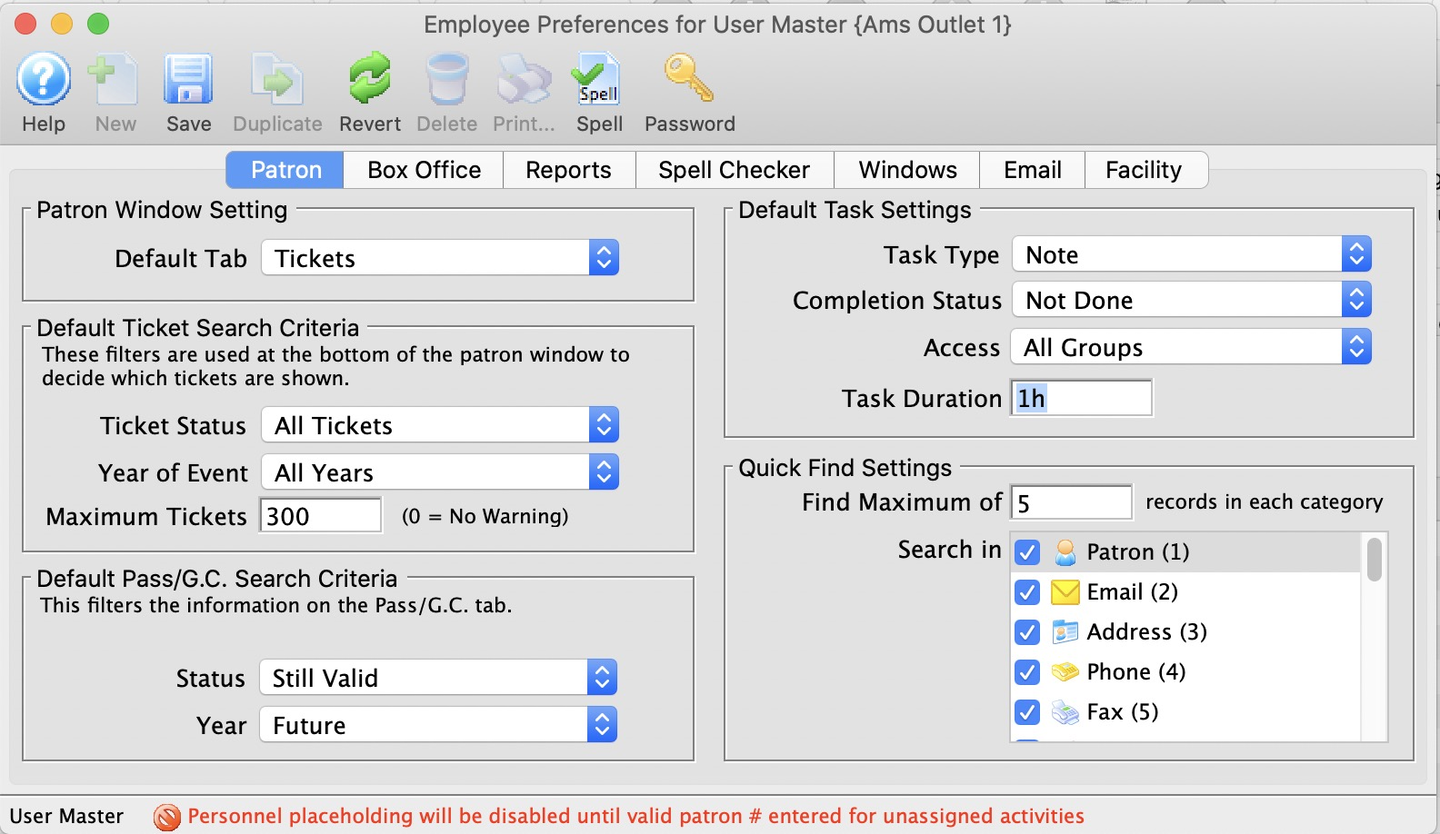
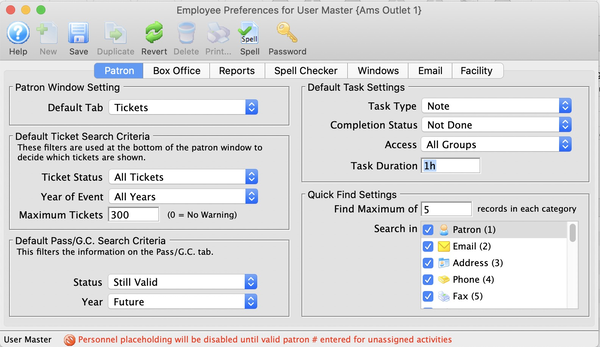
Toolbar Top


Help Button
Opens the Theatre Manager online help.


New Button
This button is not accessible because new employees must be added through the Patron Search Window. It is on the window for consistency. For more information on adding employees click here.


Save Button
Saves changes made to this window.


Duplicate Button
This button is not accessible because new employees must be added through the Patron Window. It is on the window for consistency.


Revert Button
Reverts changes made to the Employee Preferences back to the last saved point.


Delete Button
This button is not accessible because employees cannot be deleted. For more information on removing employees click here.


Print Button
Generates a report of the employee detail and access to the screen or default print location.


Spellcheck Button
Spellchecks any fields that can be typed in.


Password Button
Opens the Password Window to set an employee's password.


Patron Button
Opens the Patron Detail Window.
Patron Tab Top
This tab controls ticketing and membership default search criteria.


Patron Window Setting Top
Default Tab
You can choose which tab on the lower half of the patron window you want to land on when opening a patron window to suit your workflow best.
Default Ticket Search Criteria Top
Ticket Status
Choose the types of tickets to be displayed in the Ticket Tab. there are three choices:
- All Tickets
- Printed Tickets
- Unprinted Tickets
Year of Play
Choose the year of the tickets to be displayed in the Ticket Tab. There are 6 choices:
- Future year
- Current year
- Previous year
- Two years prior
- All Years
Maximum Tickets
The maximum number of tickets to be displayed in the Ticket Tab when the patron record is loading. If a patron has more tickets than the number specified in this field (300 in the example pictured), then a message will appear when you open that patron record informing you that 300 tickets have been found and asking if would you like to add 300 more. Clicking yes will display another 300 tickets, if there are that many more. If there are less than 300 it will just display the remainder of the tickets. By clicking no, then only the first 300 tickets will be displayed.
Default Pass/G.C. Search Criteria Top
Status
Choose the types of membership to be displayed in the Membership Tab). There are three choices:
- All Memberships
- Invalid
- Valid (not yet expired)
Year
Choose the year of the memberships to be displayed in the Membership Tab). There are 6 choices:
- Future Year
- Current Year
- Previous Year
- Two years prior
- All Years
Default Task Settings Top
Task Type
Select which task you would like as your default when creating a new one.
Completion Status
Indicates if you would like new tasks set, by default, to Not Done, In Progress, or Done.
Access
The default access to be set on a task when creating new tasks.
Duration
This field sets the default duration on new tasks you create. Durations are set in text format so that you can express many things, such as:
1m(1 min)1h 3m(1 hr, 3 min)90m(90 min)1w 2d 6h 10m(1 week, 2 days, 6 hrs, and 10 min)
The task start time is to the nearest quarter of an hour by default. The end time is dependent on your duration setting, with the default being 1 hour.
Default Quick Find Sort Order Top
Find a Maximum of
Determines the maximum number of values displayed in each of the categories you wish Theatre Manager to search for during quick find.
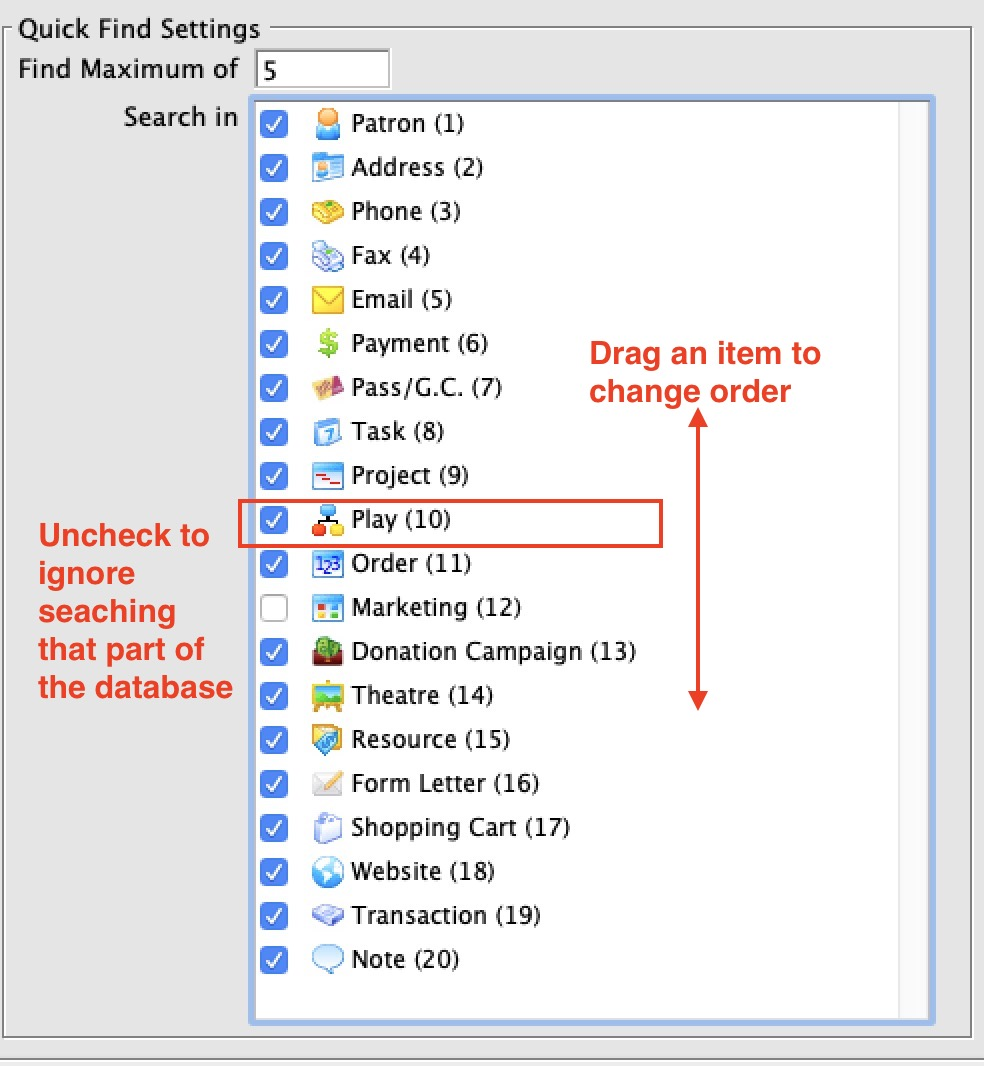
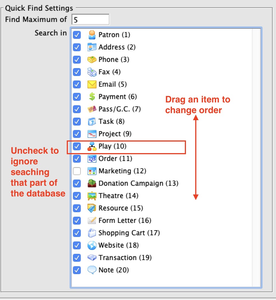
Quick Find Settings
Allows the employee to choose what values are shown when during quick find and in what order they are displayed. To change the display order, drag and drop the listings to change their sort order.
Box Office Tab Top
This tab sets sales default for the employee.
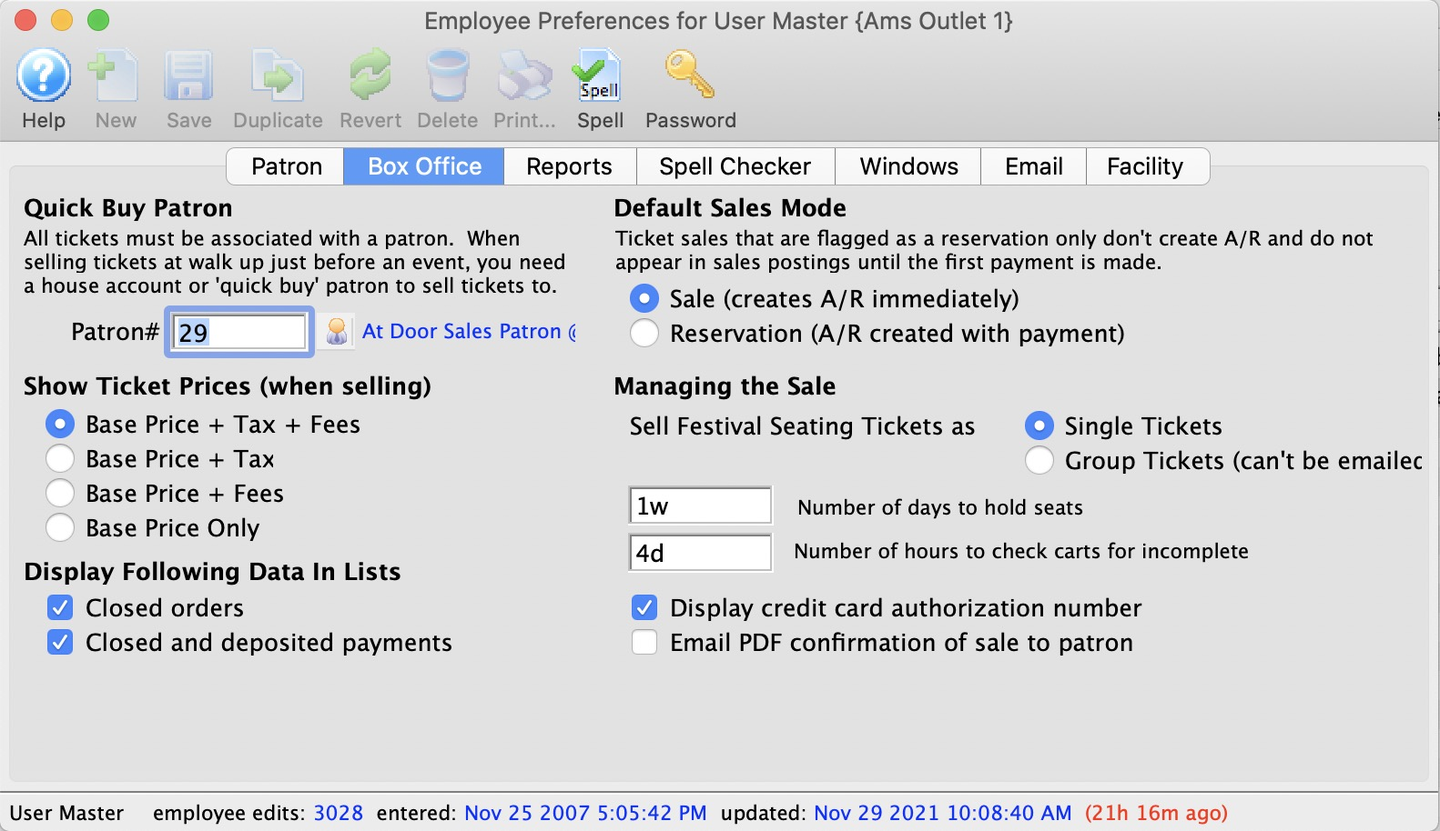
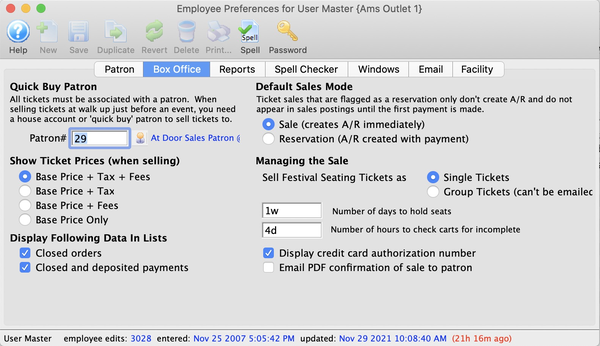
Quick Buy Patron Top
Patron#
This field requires a valid patron number. The patron number entered should be for a patron who was specifically set up to act as a dummy quick buy / before event sales patron. Each user can have their own Quick Buy / Before Event Sales Patron.
Show Ticket Prices (when selling) Top
This setting controls how ticket prices are previewed on the running calculator of the Order Window. There are four options:
- Base Price + Tax + Fee: displays the base price plus tax any fees associated with the sales promotion
- Base Price + Tax: displays as the base price plus tax
- Base Price + Fees: displays as the base price plus fees associated with the sales promotion
- Base Price Only: displays as the base price only
Display Following Data in List Top
Closed Orders
Fully paid orders will be displayed
Closed and Deposited Payments
Payments for fully paid orders will be displayed
Default Sales Mode Top
Sale
Purchases are recognized as an accounts receivable at the time of purchase. If payment is made the accounts receivable is cleared. If no payment is made the tickets remain on account until the payment is received.
Reservation
Purchases is not recognized as an accounts receivable until the first payment or donation is received. This will only take effect if permitted in Company Preferences >> Accounting Tab and is not a recommended practice.
Managing the Sale Top
Single Tickets Festival seating tickets are issued as one ticket per admission.
Group Tickets*
Festival seating tickets are issues as one ticket per event and one ticket may be good for XX admissions (group sale tickets means that the ticket can never be emailed).
Default Number of Days to Hold Seats
Default number of days a patron seat request will be held for an event
Number of Hours to Check Carts for Incomplete Sales
Number of hours that must pass before notification of any checked out but incomplete carts. These carts can be seen in the Shopping Cart List.
Display Credit Card Authorization Number
Credit card authorization number is displayed in the payment window before completing a sale
Email PDF Confirmation of Sale to Patron
Indicates that the employee prefers to email a PDF copy of the sale confirmation to the patron for a box office or phone order. If this is:
- Checked: the employee will automatically see an email prompt window open after the sale is completed that will email the PDF invoice to the customer. The employee can cancel out of the emailing window and nothing is sent.
- Not Checked: the employee will not see the prompt, but they can manually choose to end a confirmation or invoice to the customer by clicking on the invoice at the top of the payment window.
Reports Tab Top
This tab controls reporting preferences for the employee.
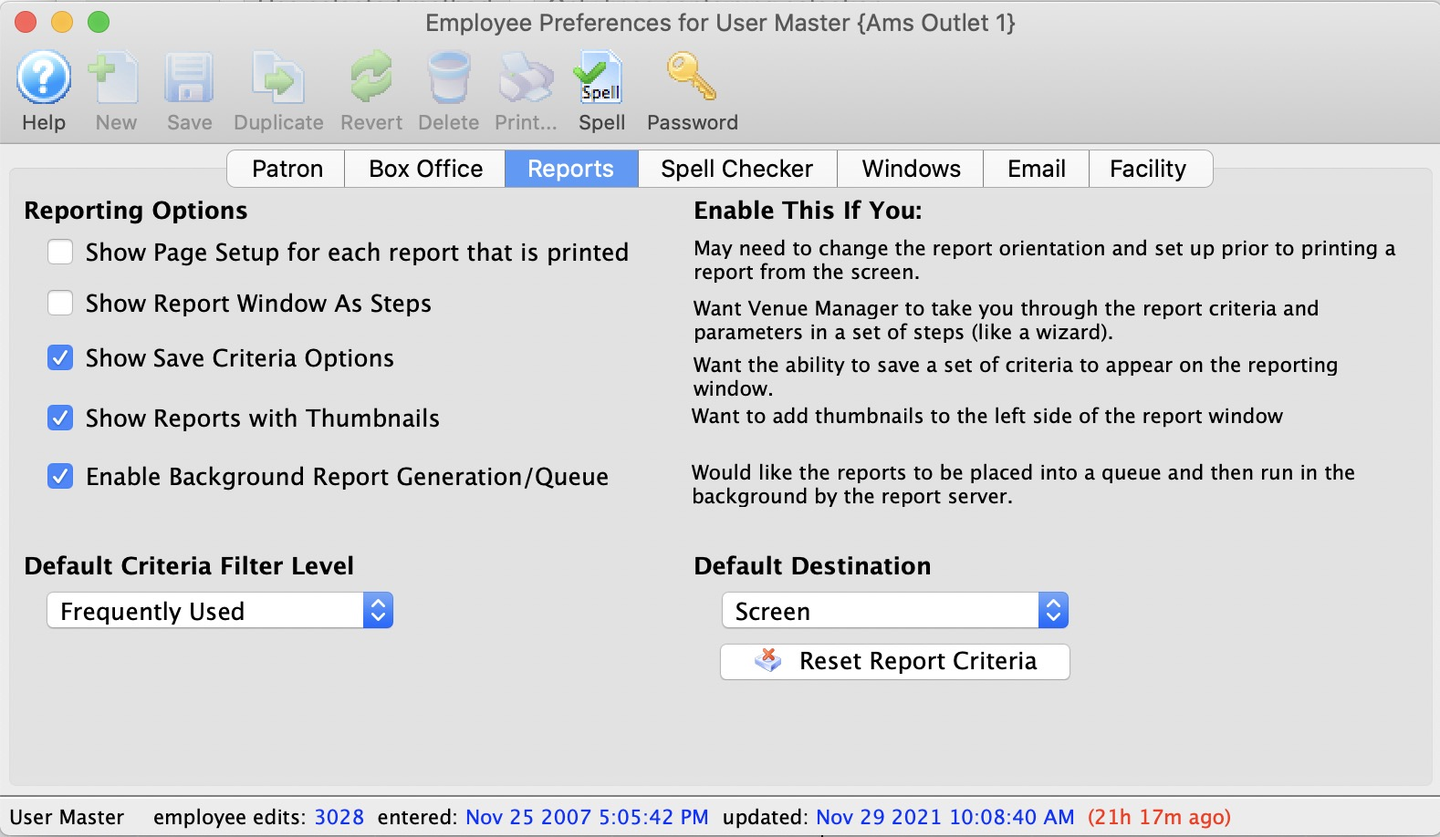
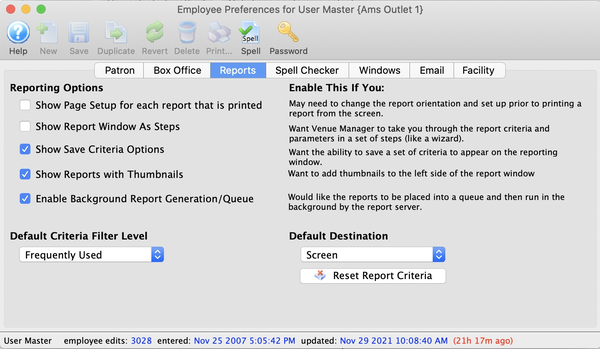
Show Page Setup for Each Report
When checked the user will always be given the opportunity to change the page orientation and paper size before printing a report even if the default destination is to the screen. If you use the same printer and page size each time, you might wish to disable this feature.
However, if you are using a number of different reports and page widths, you may wish to enable the feature.
Show Report Window as Steps
Changes the criteria window to a series of next/previous windows rather than tabs. This assists infrequent users in entering relevant information.
Show Saved Criteria Options
When unchecked, will remove the Save Criteria buttons to reduce the number of buttons in the criteria window for simplicity.
Show Report in Page Preview Mode
When checked, reports on screen are displayed is actual view with the paper outline. This is the now the default for 64-bit Theatre Manager and cannot be disabled. The reports also show thumbnails, and you can zoom in using the context menu.
Enable Background Report Generation
When checked, reports can be sent to a background queue where they will run on a TM server instead of your workstation. It means you can have multiple reports running simultaneously and view them using the Queue button on the report window.
{% end %}
Default Criteria Filter Level
Can change the default criteria filter level to make choosing fields for search criteria more simple. Options are:
- All
- Frequently Used
- Essential
Default Destination
A dropdown list allowing users to specify the default print location. There are five options:
- Clipboard
- File
- Page Preview
- Printer
- Screen
Reset Report Criteria
Removes/clears/resets any of the saved report criteria and report export settings.
Spell Checker Top
This tab controls the employee's spellcheck default settings.
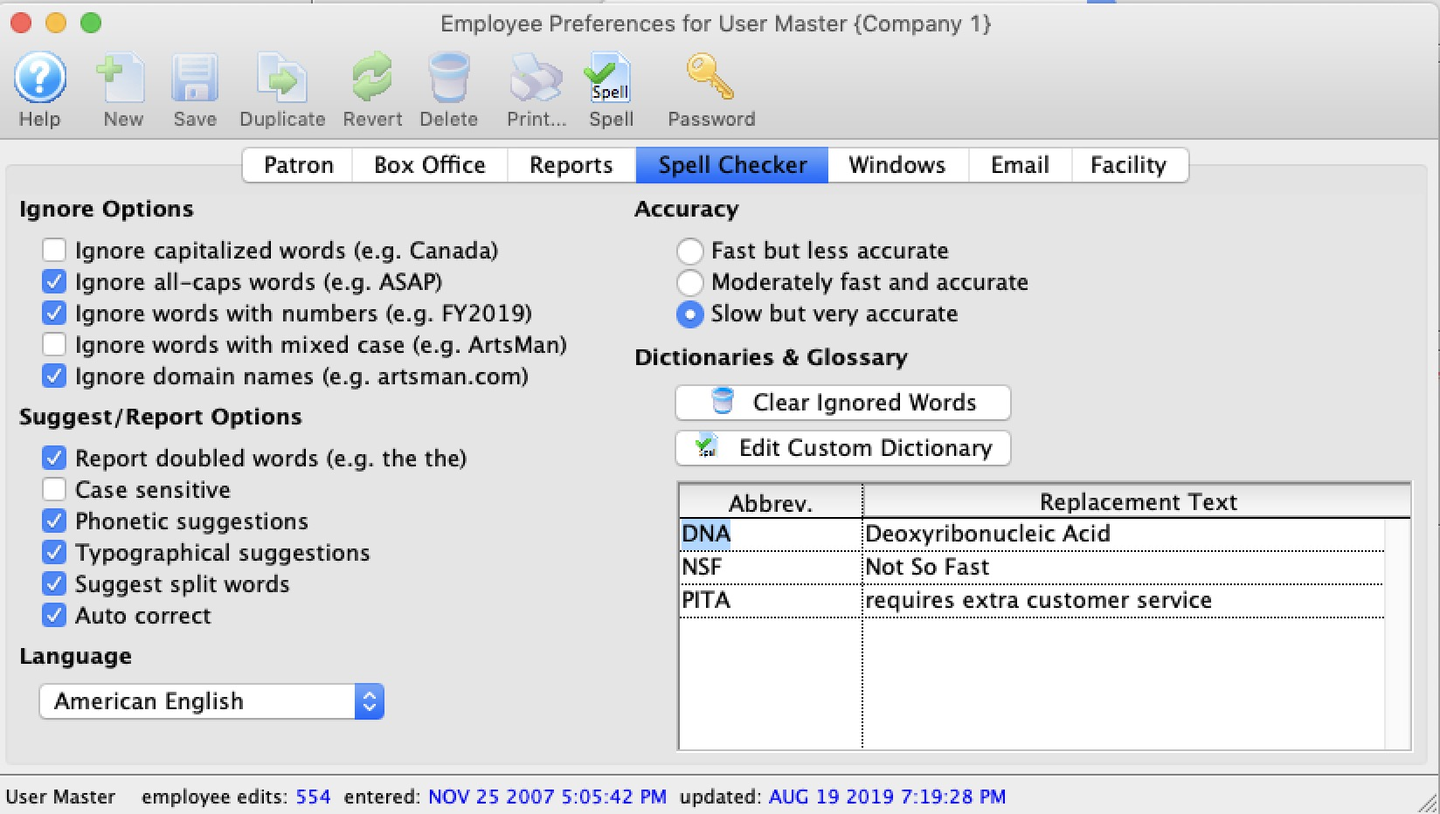
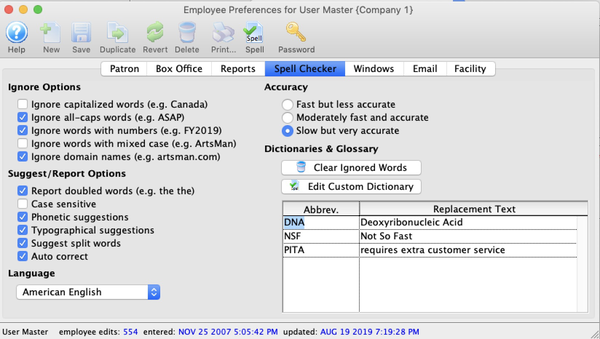
Ignore Options Top
Ignore Capitalized Words
Ignores capitalized words found in the middle of a sentence (e.g. "Patron will call back on Thursday to provide payment").
Ignore All-Caps Words
Ignores words completely capitalized (e.g. "Patron works at WGYN but manages tickets for the DSIC group").
Ignore Words With Numbers
Ignores words that contain both letters and numbers (e.g. "See event 23-PET and 23-PYZ for vip experience offers").
Ignore Words With Mixed Case
Ignores mixed case words (e.g. "See case #245678 with ArtsMan").
Ignore Domain Names
Ignores domain names for email or websites. Often domain names are a combination of words that run together (e.g. "artsman.com").
Suggest Options Top
Report Doubled Words
Detects same words typed side by side (e.g. "See the order notes for season control house").
Case Sensitive
Locates words that should be capitalized but are not (e.g. "Patron spends summers in canada").
Phonetic Suggestions
Displays word suggestions that sound like the misspelled word. Either phonetic suggestions or typographical suggestions must be selected in order for spell check to provide suggestions.
Typographical Suggestions
Displays word suggestions that appear similar to the misspelled word. Either phonetic suggestions or typographical suggestions must be selected in order for spell check to provide suggestions.
Suggest Split Words
Displays suggestions for words that appear to run together.
Auto Correct
Detects words within the selected dictionary marked as auto change and correct them without prompting (e.g. changing "teh" to "the").
Language
Select a language to spell check in. The choices are American English, British English, Dutch, French, German, Italian, and Spanish.
Accuracy Top
Fast but Less Accurate
A fast scan of the source document which may provide less accurate spell check results.
Moderately Fast and Accurate
A quick scan of the source document which moderate accuracy.
Slow but Very Accurate
A slow, accurate scan of the source document.
Dictionaries & Glossary Top


Clear Ignores Button
When ignore all is selected during spell check the words are stored for future reference. Clear ignores removes these words from the stored reference.


Edit Dictionary Button
Edit the spell check dictionary. Exclude, Ignore, Conditionally Changes and Auto Changes can be adjusted in the dictionary.
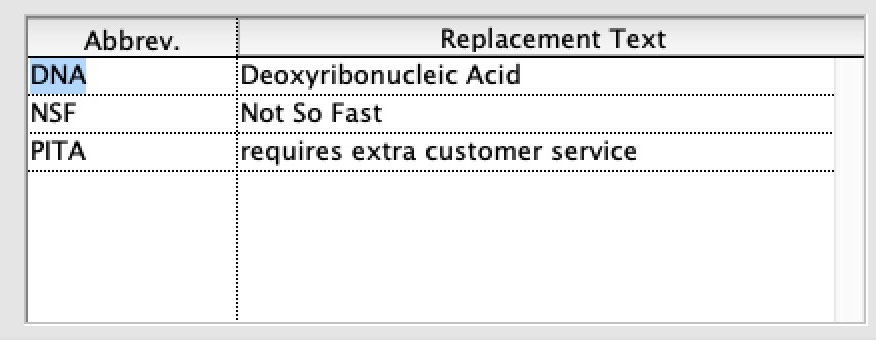
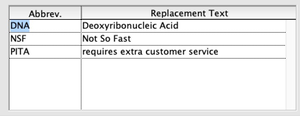
Abbreviations
Enter any short forms and what you would like them expanded to. These short forms work in most fields and can be used to quickly replace the text you type with a more prosaic version. There are some standard (built-in) short forms like:
- xDay - the day of the week in full format (e.g. "Monday")
- xDate - the current date in full format (e.g. "June 12, 2019")
- xTime - the current time in 12-hour format with am/pm
- xNow - the current date/time in timestamp format (yyyy-mm-dd HH:MM:SS)
So you could type a short form like xNow NSF and it would expand to 2019-08-20 6:28 am Not So Fast using both the standard abbreviation and one you created for yourself.
Windows Tab Top
This tab controls the employee's status bar location.
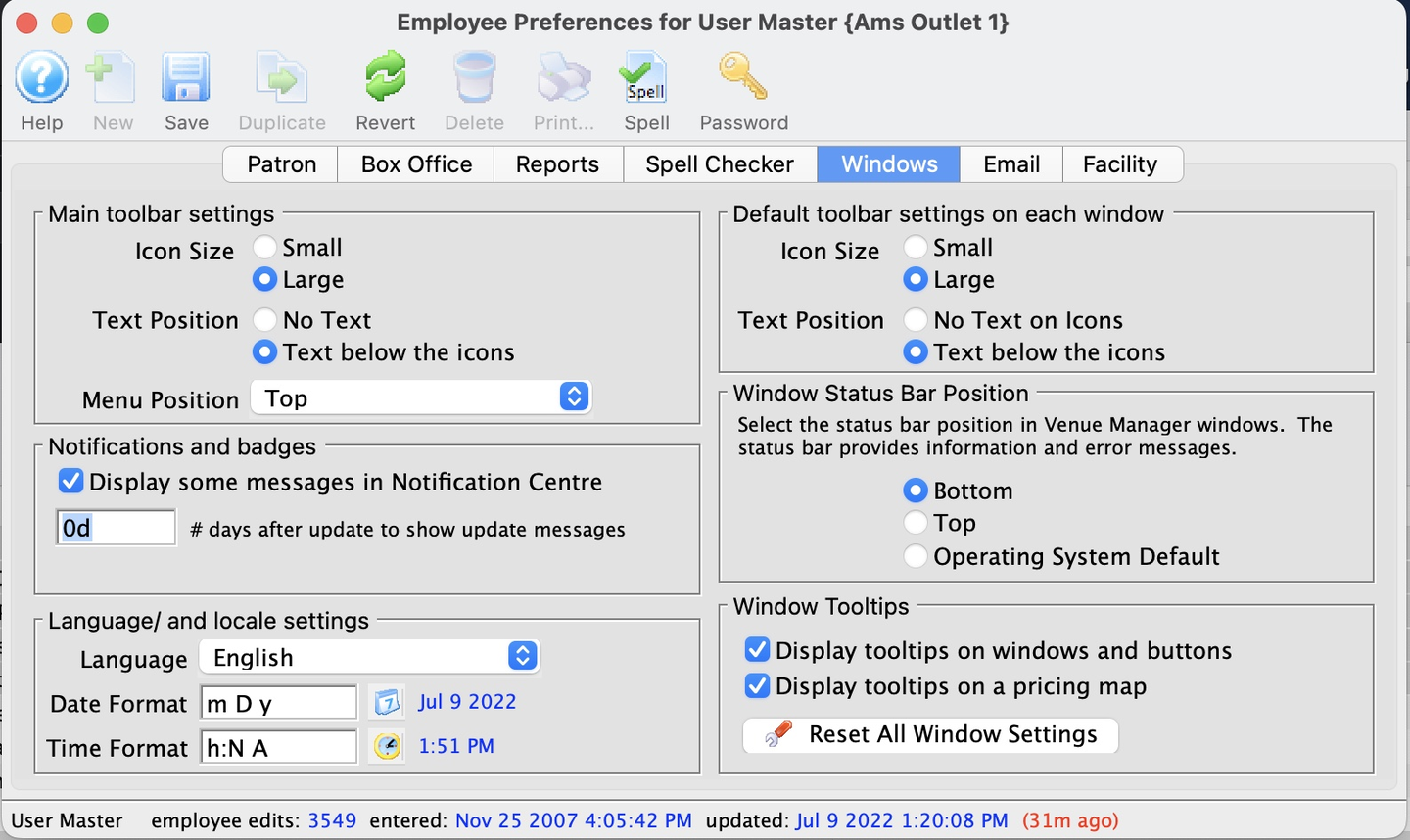
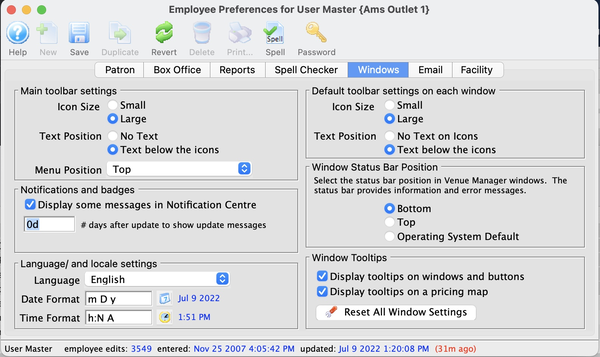
Main Toolbar Settings Top
Icon Size
Choice between small or large icons on Theatre Manager's Main Toolbar.
Text Position
You can either have no text or text showing below the main toolbar icons.
Menu Position
Sets where you would like the menu positioned on the screen. The options are None, Top, Bottom, Left, Right, or Floating.
Window Tooltips Top
Display Tooltips on Windows and Buttons
Displays tips on windows and buttons when the mouse is hovered over top of the window or button.
Display Tooltips on a Theatre Map
Displays seat information when mouse is hovered over top of seat on a theatre map.
Reset Window Positions
This will reset all window positions and other column/sort settings back to the default when clicked. Optionally, if you are a master user, you can reset for all users. Otherwise, only your employee settings are cleared. Read more about how to reset windows.
Notifications Top
Updates
You can set the number of days that update notices will show in the daily Notification Window on startup of Theatre Manager. This can be useful if you've been away and want to see auto-updates or manually installed updates. Clicking on a row in the notification window will let you click the Explain button to see the release notes. Set this number to zero if you do not want any notifications that an update occurred.
Display Some Messages in Notification Center
Displays some alerts in the notification centre on your Macintosh (no Windows equivalent yet).
Number Days to Show Update Messages
The number of days after an update has been released to show it in the startup messages list (for informational and reminder purposes).
Preferred Toolbar Icon Settings Top
Icon Size
Choose between small or large icons for the many windows and toolbars in Theatre Manager.
Text Position
You can either have no text or text descriptors showing below your icons.
Window Status Bar Position
Sets where you would like Theatre Manager status bar positioned. This status bar displays information, subtotals, and any errors you may receive. The options are "Bottom", "Top", or "Operating System Default".
Language and Locale Settings Top
Language Preference
Sets the default language, date, and time. Click on the dropdown bar to select a language: Deutsch, English, Espanol, Francais, or Italiano.
Date Display
Click on the calendar icon to set the default date. A popup window will provide a list of date formats to choose from.
Time Display
Click on the clock icon to set the default time. A popup window will provide a list of time formats to choose from.
Email Tab Top
This tab is where the employee's email setup lives.
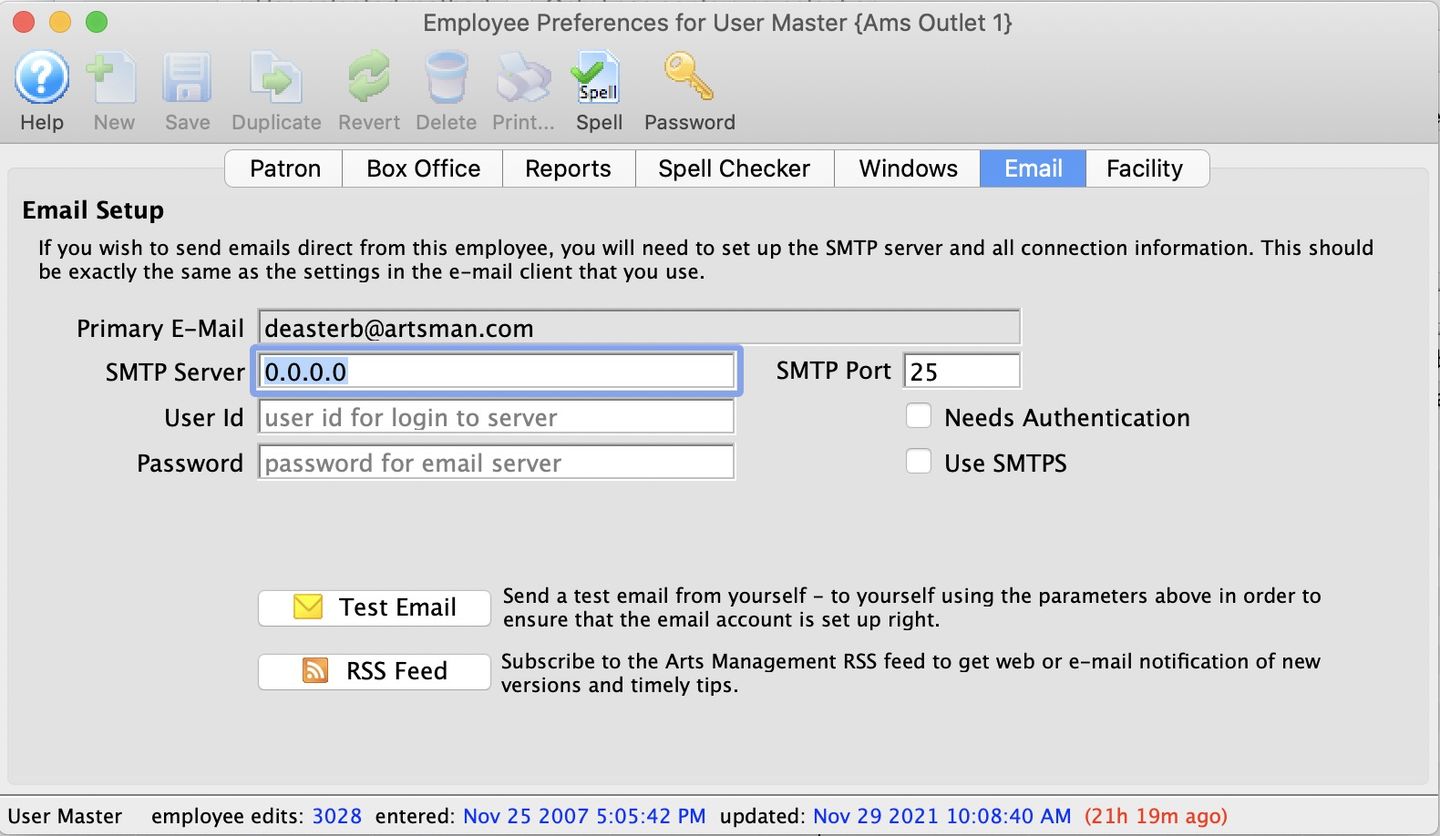
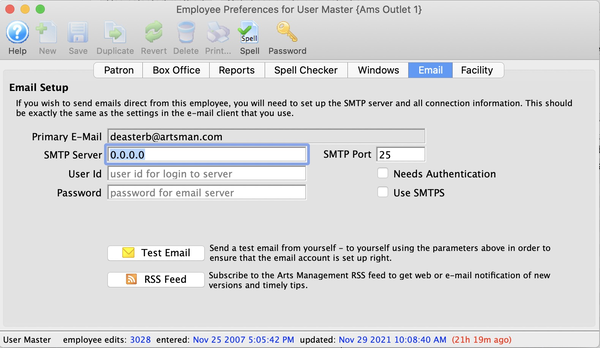
Primary E-Mail
Automatically generated from the primary email as set up on the employee's patron record.
SMTP Server
The company's SMTP server to send emails to/from this employee.
SMTP Port
This is the port used to talk to the SMTP server for email sending to/from the web listener for this employee.
User ID
In cases where authentication is necessary, the employee's email user id login for the SMTP server.
Password
In cases where authentication is necessary, the employee's password for their user id for the SMTP server.
Rate Limited Until
If the field is visible, you will see a rate-limit timestamp. This indicates the next time that Theatre Manager will attempt to send an email using this account since it believes you have reached your maximum allowable email limit as determined by your ISP.
Needs Authentication Box
Check this box if authentication is required to access the SMTP server. Encryption methods are "none", "login", "plain", "cleartext", and "cram-md5".
Use SMTPS Box
Check this box if the SMTP server requires SMTPS for connection. TLS/StartTLS are supported automatically.


Test Email Button
Click the Test Email button to send a test email using the SMTP settings as entered.
Facility Tab Top
This tab controls the Facilities Management setup for the employee.
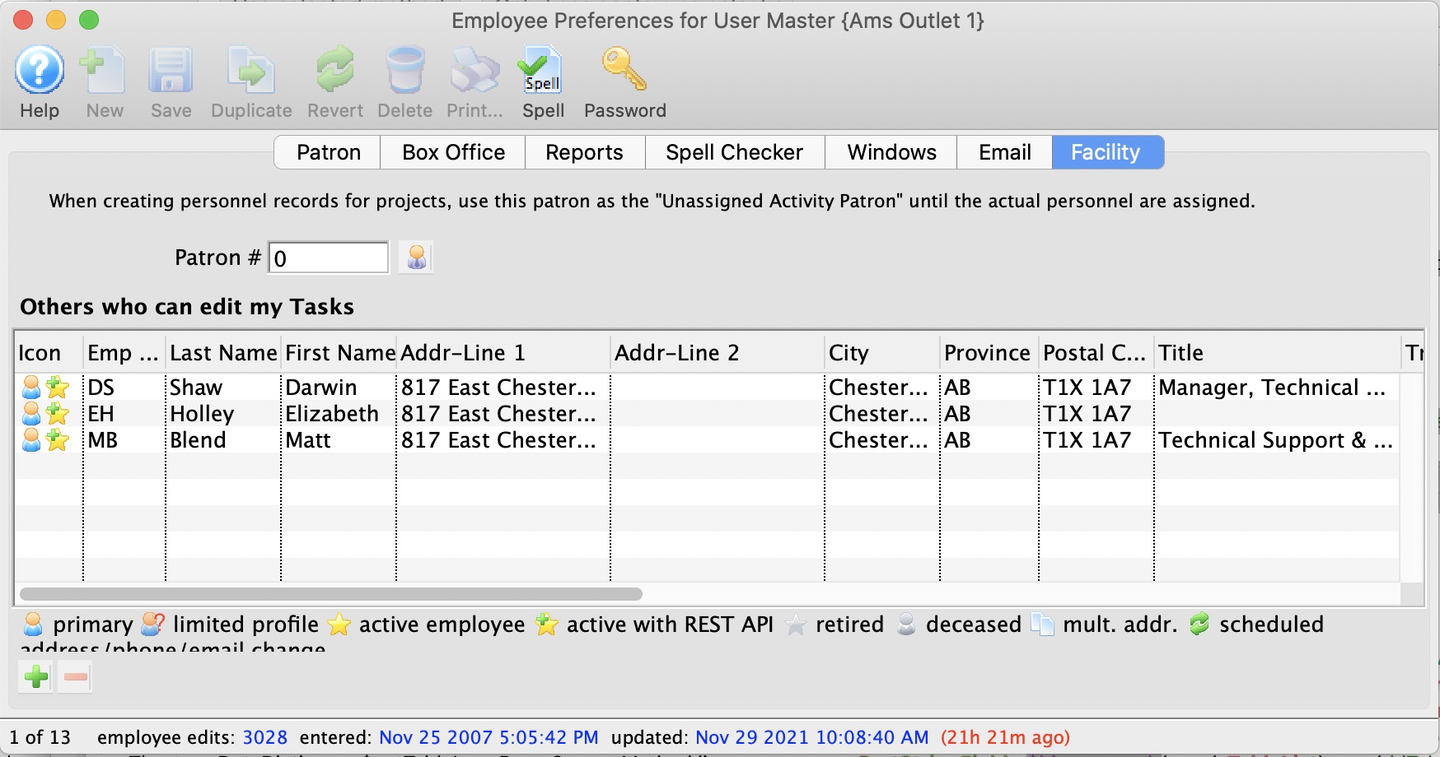
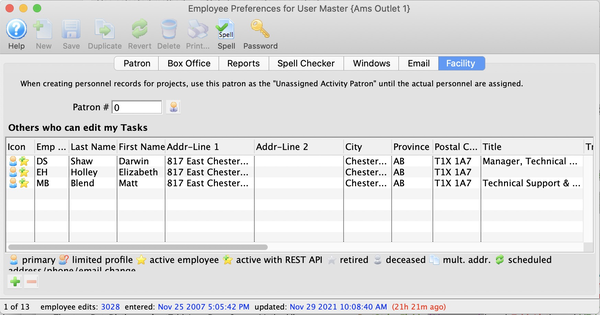
Unassigned Activity Patron
Enter a default unassigned activity patron here. The purpose of this patron is to let you assign placeholders for tasks in the Facility Management module. When Theatre Manager assigns a placeholder patron to tasks, it uses this patron. This way, you can have a task that requires 5 people, but not yet know who those 5 people are. Add 5 generic/placeholder patrons to the task, then replace them with real patrons when you are ready. This patron is often used in the Volunteer/Personnel Tab in events/performances to set up the number of people needed to work a performance.
If you receive the message Personnel placeholding will be disabled until valid Unassigned Activity Patron # entered, then you need to add a generic patron to this cell.
Others Who Can Edit My Tasks
Here you can assign delegates who can edit your calendar task information. This prevents others from changing your tasks by supplying a list of authorized editors. Use the green plus and red minus buttons at the bottom left of the table to add or remove patrons from this list.